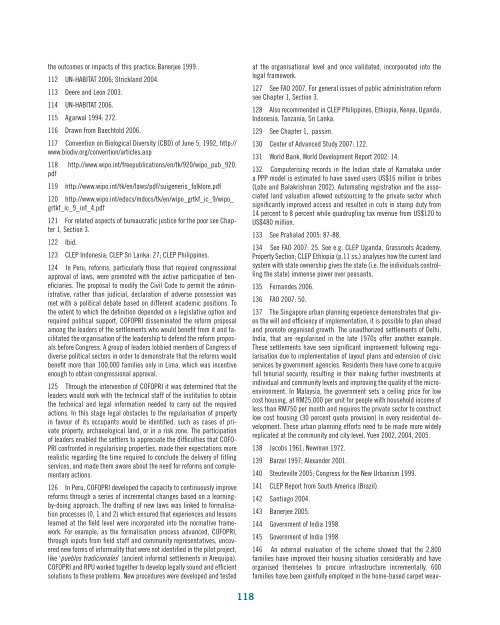Download the file - United Nations Rule of Law
Download the file - United Nations Rule of Law
Download the file - United Nations Rule of Law
Create successful ePaper yourself
Turn your PDF publications into a flip-book with our unique Google optimized e-Paper software.
<strong>the</strong> outcomes or impacts <strong>of</strong> this practice. Banerjee 1999..112 UN-HABITAT 2006; Strickland 2004.113 Deere and Leon 2003.114 UN-HABITAT 2006.115 Agarwal 1994: 272.116 Drawn from Baechtold 2006.117 Convention on Biological Diversity (CBD) <strong>of</strong> June 5, 1992, http://www.biodiv.org/convention/articles.asp118 http://www.wipo.int/freepublications/en/tk/920/wipo_pub_920.pdf119 http://www.wipo.int/tk/en/laws/pdf/suigeneris_folklore.pdf120 http://www.wipo.int/edocs/mdocs/tk/en/wipo_grtkf_ic_9/wipo_grtkf_ic_9_inf_4.pdf121 For related aspects <strong>of</strong> bureaucratic justice for <strong>the</strong> poor see Chapter1, Section 3.122 Ibid.123 CLEP Indonesia; CLEP Sri Lanka: 27; CLEP Philippines.124 In Peru, reforms, particularly those that required congressionalapproval <strong>of</strong> laws, were promoted with <strong>the</strong> active participation <strong>of</strong> beneficiaries.The proposal to modify <strong>the</strong> Civil Code to permit <strong>the</strong> administrative,ra<strong>the</strong>r than judicial, declaration <strong>of</strong> adverse possession wasmet with a political debate based on different academic positions. To<strong>the</strong> extent to which <strong>the</strong> defi nition depended on a legislative option andrequired political support, COFOPRI disseminated <strong>the</strong> reform proposalamong <strong>the</strong> leaders <strong>of</strong> <strong>the</strong> settlements who would benefit from it and facilitated<strong>the</strong> organisation <strong>of</strong> <strong>the</strong> leadership to defend <strong>the</strong> reform proposalsbefore Congress. A group <strong>of</strong> leaders lobbied members <strong>of</strong> Congress <strong>of</strong>diverse political sectors in order to demonstrate that <strong>the</strong> reforms wouldbenefi t more than 100,000 families only in Lima, which was incentiveenough to obtain congressional approval.125 Through <strong>the</strong> intervention <strong>of</strong> COFOPRI it was determined that <strong>the</strong>leaders would work with <strong>the</strong> technical staff <strong>of</strong> <strong>the</strong> institution to obtain<strong>the</strong> technical and legal information needed to carry out <strong>the</strong> requiredactions. In this stage legal obstacles to <strong>the</strong> regularisation <strong>of</strong> propertyin favour <strong>of</strong> its occupants would be identifi ed, such as cases <strong>of</strong> privateproperty, archaeological land, or in a risk zone. The participation<strong>of</strong> leaders enabled <strong>the</strong> settlers to appreciate <strong>the</strong> diffi culties that COFO-PRI confronted in regularising properties, made <strong>the</strong>ir expectations morerealistic regarding <strong>the</strong> time required to conclude <strong>the</strong> delivery <strong>of</strong> titlingservices, and made <strong>the</strong>m aware about <strong>the</strong> need for reforms and complementaryactions.126 In Peru, COFOPRI developed <strong>the</strong> capacity to continuously improvereforms through a series <strong>of</strong> incremental changes based on a learningby-doingapproach. The drafting <strong>of</strong> new laws was linked to formalisationprocesses (0, 1 and 2) which ensured that experiences and lessonslearned at <strong>the</strong> fi eld level were incorporated into <strong>the</strong> normative framework.For example, as <strong>the</strong> formalisation process advanced, COFOPRI,through inputs from fi eld staff and community representatives, uncoverednew forms <strong>of</strong> informality that were not identifi ed in <strong>the</strong> pilot project,like ‘pueblos tradicionales’ (ancient informal settlements in Arequipa).COFOPRI and RPU worked toge<strong>the</strong>r to develop legally sound and effi cientsolutions to <strong>the</strong>se problems. New procedures were developed and testedat <strong>the</strong> organisational level and once validated, incorporated into <strong>the</strong>legal framework.127 See FAO 2007. For general issues <strong>of</strong> public administration reformsee Chapter 1, Section 3.128 Also recommended in CLEP Philippines, Ethiopia, Kenya, Uganda,Indonesia, Tanzania, Sri Lanka.129 See Chapter 1, passim.130 Center <strong>of</strong> Advanced Study 2007: 122.131 World Bank, World Development Report 2002: 14.132 Computerising records in <strong>the</strong> Indian state <strong>of</strong> Karnataka undera PPP model is estimated to have saved users US$16 million in bribes(Lobo and Balakrishnan 2002). Automating registration and <strong>the</strong> associatedland valuation allowed outsourcing to <strong>the</strong> private sector whichsignifi cantly improved access and resulted in cuts in stamp duty from14 percent to 8 percent while quadrupling tax revenue from US$120 toUS$480 million.133 See Prahalad 2005: 87-88.134 See FAO 2007: 25. See e.g. CLEP Uganda, Grassroots Academy,Property Section; CLEP Ethiopia (p.11 ss.) analyses how <strong>the</strong> current landsystem with state ownership gives <strong>the</strong> state (i.e. <strong>the</strong> individuals controlling<strong>the</strong> state) immense power over peasants.135 Fernandes 2006.136 FAO 2007: 50.137 The Singapore urban planning experience demonstrates that given<strong>the</strong> will and effi ciency <strong>of</strong> implementation, it is possible to plan aheadand promote organised growth. The unauthorized settlements <strong>of</strong> Delhi,India, that are regularised in <strong>the</strong> late 1970s <strong>of</strong>fer ano<strong>the</strong>r example.These settlements have seen signifi cant improvement following regularisationdue to implementation <strong>of</strong> layout plans and extension <strong>of</strong> civicservices by government agencies. Residents <strong>the</strong>re have come to acquirefull tenurial security, resulting in <strong>the</strong>ir making fur<strong>the</strong>r investments atindividual and community levels and improving <strong>the</strong> quality <strong>of</strong> <strong>the</strong> microenvironment.In Malaysia, <strong>the</strong> government sets a ceiling price for lowcost housing, at RM25,000 per unit for people with household income <strong>of</strong>less than RM750 per month and requires <strong>the</strong> private sector to constructlow cost housing (30 percent quota provision) in every residential development.These urban planning efforts need to be made more widelyreplicated at <strong>the</strong> community and city level. Yuen 2002, 2004, 2005.138 Jacobs 1961; Newman 1972.139 Barzel 1997; Alexander 2001.140 Steuteville 2005; Congress for <strong>the</strong> New Urbanism 1999.141 CLEP Report from South America (Brazil).142 Santiago 2004.143 Banerjee 2005.144 Government <strong>of</strong> India 1998.145 Government <strong>of</strong> India 1998.146 An external evaluation <strong>of</strong> <strong>the</strong> scheme showed that <strong>the</strong> 2,800families have improved <strong>the</strong>ir housing situation considerably and haveorganised <strong>the</strong>mselves to procure infrastructure incrementally. 600families have been gainfully employed in <strong>the</strong> home-based carpet weav-118
















